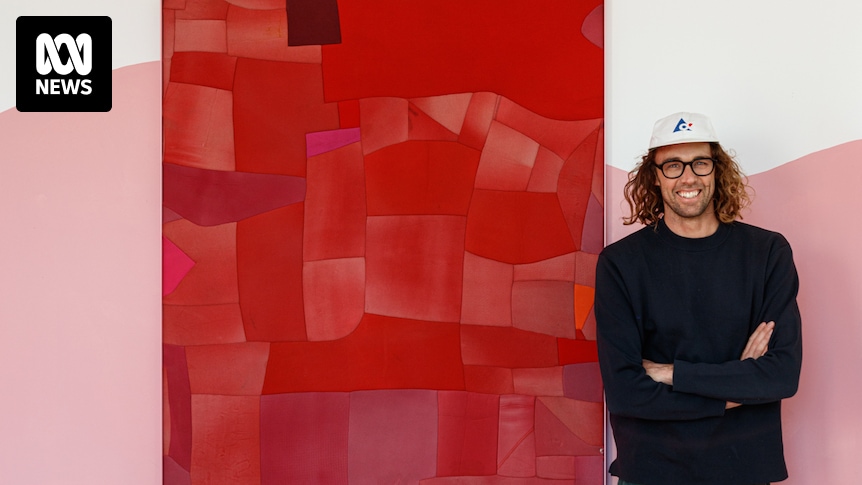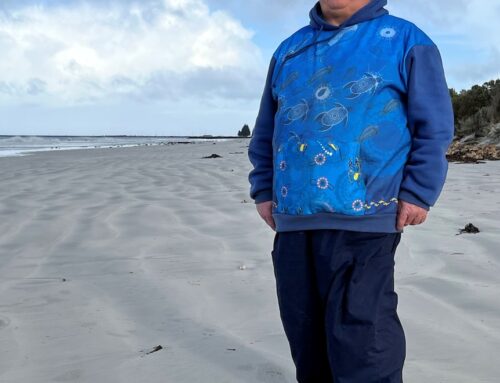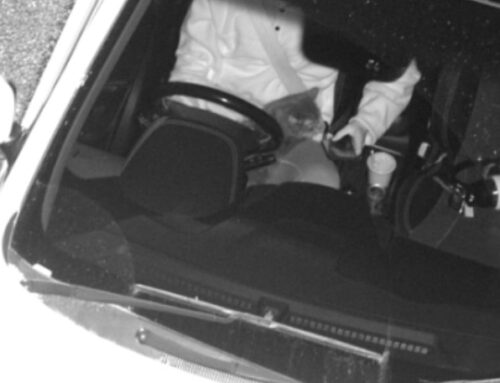Hair dripping wet and still wearing his wetsuit, surfer and artist Henry Jock Walker is just getting back from a “cheeky halfa salty dip” — aka a quick arvo surf.
I’ve just arrived at his studio south of Adelaide, which conveniently sits a few streets back from the beach on the beautiful coast-lined Fleurieu Peninsula.
The particular wetsuit or “wettie” he’s got on is maroon with a stripe of blue — but that is just the very beginning of his collection.
Inside Walker’s backyard studio there’s an explosion of colourful neoprene — stapled onto walls, filling bags, spilling out of shelves, and splayed out on the large making table.
“I’ve been collecting the wetsuits for many years now, maybe even 10 to 15 years,” says Walker.
“I worked at a surf school at Port Noarlunga, so a lot I collected from Porties, and then op shops and mates, and there’s a lot of my old wetsuits.
“Because I’ve been working with the material for a while now, and it’s pretty obvious, they kind of come at me from different angles! I just get bags dropped off on my door a lot, or I get to work and someone’s got a bag of wetsuits for me.”
For this surfer artist, the vibrant, nostalgic fabric is his version of paint.
When I visit, Walker is busy prepping for his upcoming exhibition, aptly titled Ultra Flex.
He reaches for colourful slices of neoprene, and thoughtfully places them alongside each other, considering how the hues and shapes could interact.
“They look like abstract paintings,” he says.
“I like to think about it like you would someone that’s an oil painter,” he says.
“You know, they spend the thousands and thousands of hours practising their technique — for me, that’s surfing. I’ve already practised my technique and I’ve done the research for 20-plus years; I know all the insides and outs of surfing. So I like to lean into that and utilise that as a foundation for my art practice.”
Over the last few years he’s shown in galleries across Australia, along with exhibitions in Tokyo, LA and Seattle. He’s also got upcoming plans in Europe, collaborating with some design-world surfers in Zurich.
“I get lots of different responses. I get a kind of a curious engagement from kids — they want to touch them, like, ‘what is it?’ There’s always a real want to touch them, which is really nice. I think they feel good!” he says.
For each show, Walker likes to hone in on a particular section of his large wetsuit collection, and give himself different parameters to work within.
For instance, he challenged himself to only use 200-plus faded red wetsuits donated from the local aquatics camp, and created large-scale monochromatic “pink” paintings.
“I explore different strategies, it changes each time — then I make discoveries inside that kind of zone,” he says.
“The last show, I only used wetsuits that I found in my old van — I had a whole stack of wetsuits in there, I didn’t actually realise how many were still in there, and then I limited myself [to just using them].
“This show I’ve really opened it up and gone like, ‘Nah, I’m getting all of my colours out,’ and I’m just going on a big flare.”
He describes the process of making the wetsuit paintings as “like quilting”.
“Once I’ve sewed them together, I stretch it around a wood sub-frame,” Walker explains.
“That pulls them tight and kind of transforms them into something — it goes from a floppy thing on the ground, to being in this taut situation.
“It feels more like a painting I think from afar, but then if you get up close, you can kind of understand that the texture’s a little bit different.”
Walker says he is constantly discovering new ways to create with neoprene, and is inspired to keep experimenting and evolving his practice; he’s beginning to use it to make sculptures, and is interested in how it could be applied in costume and architecture.
But there’s a few other reasons he keeps using the second-hand wetsuits to make art.
“The sustainability reason is a huge one for me,” Walker says.
“I feel a lot better about a found, second-hand plastic than buying new plastic [paint is plastic] and spreading layers of that on canvas — canvas itself isn’t a very sustainable material.”
Additionally, the material itself contains all sorts of mysterious stories — from the bodies the wetsuits have stretched over, to the oceans they’ve immersed in, and all the aquatic activities those bodies have done.
“Because it’s a used material, you get a feeling that in some way it’s got a spirit, because the material’s had a life,” he says.
“It’s not something that I’m making from a [paint] tube, it’s something that’s already been out in the world on an adventure, and then I’m playing with that. There is a feeling of that physical existence, outside of just what the material looks like on a flat surface.”
Anyone that’s worn a wetty knows that part of the “spirit” of the material is, well, the occasional ocean wee.
“There’s sometimes a pee, wee smell. I really like that, I mean sometimes if they smell really bad I’ll wash them but I think there’s something really great about the humaneness of that.
“That’s a part of the grit of the material and that’s part of what makes it real. I think on the most part I’d rather it be real…unless it absolutely stinks and then I obviously wash it! But normally they’re pretty good.”
Henry Jock Walker: Ultra Flex is at Egg & Dart, Wollongong until April 27.




